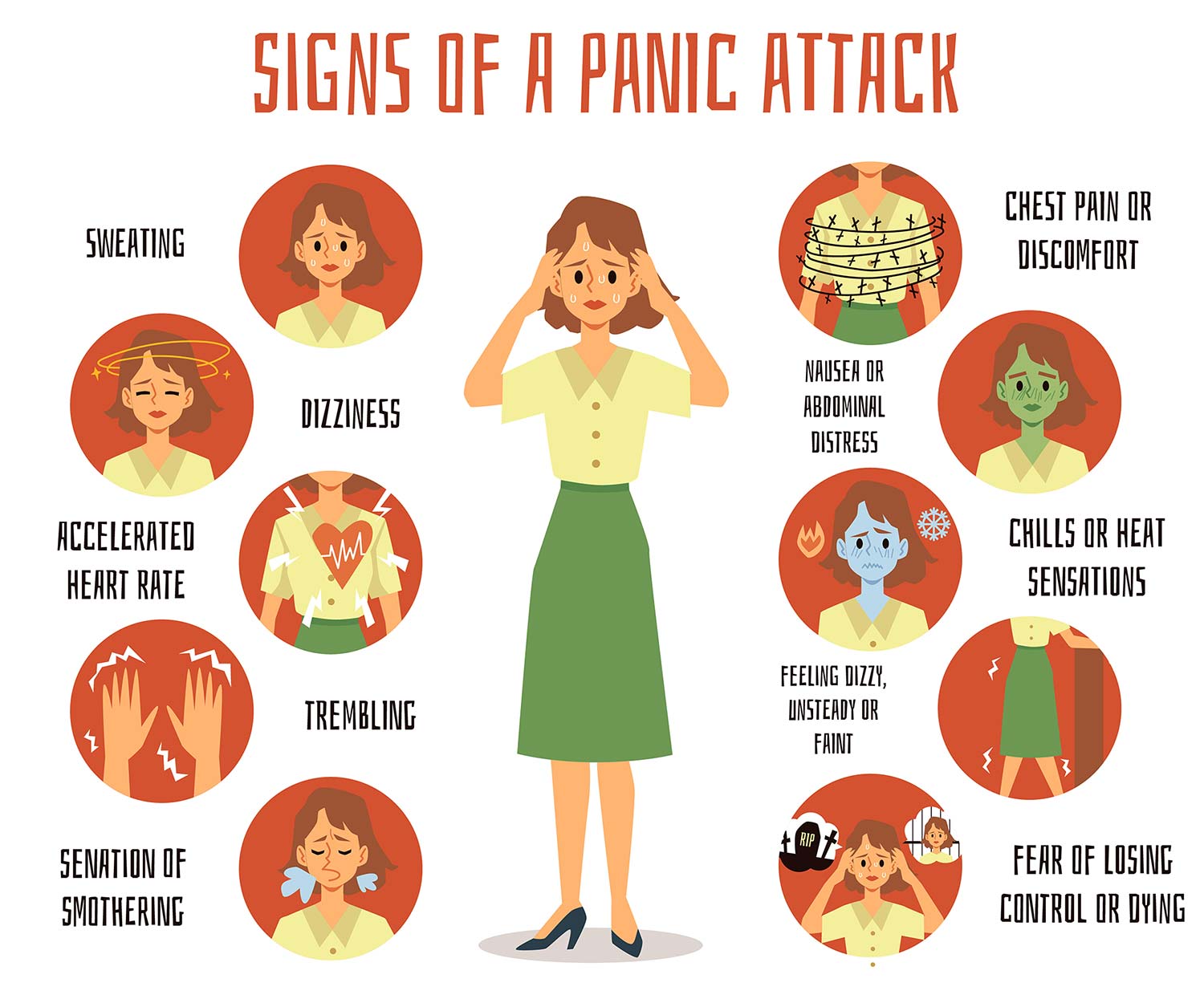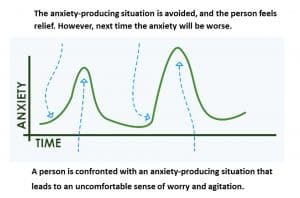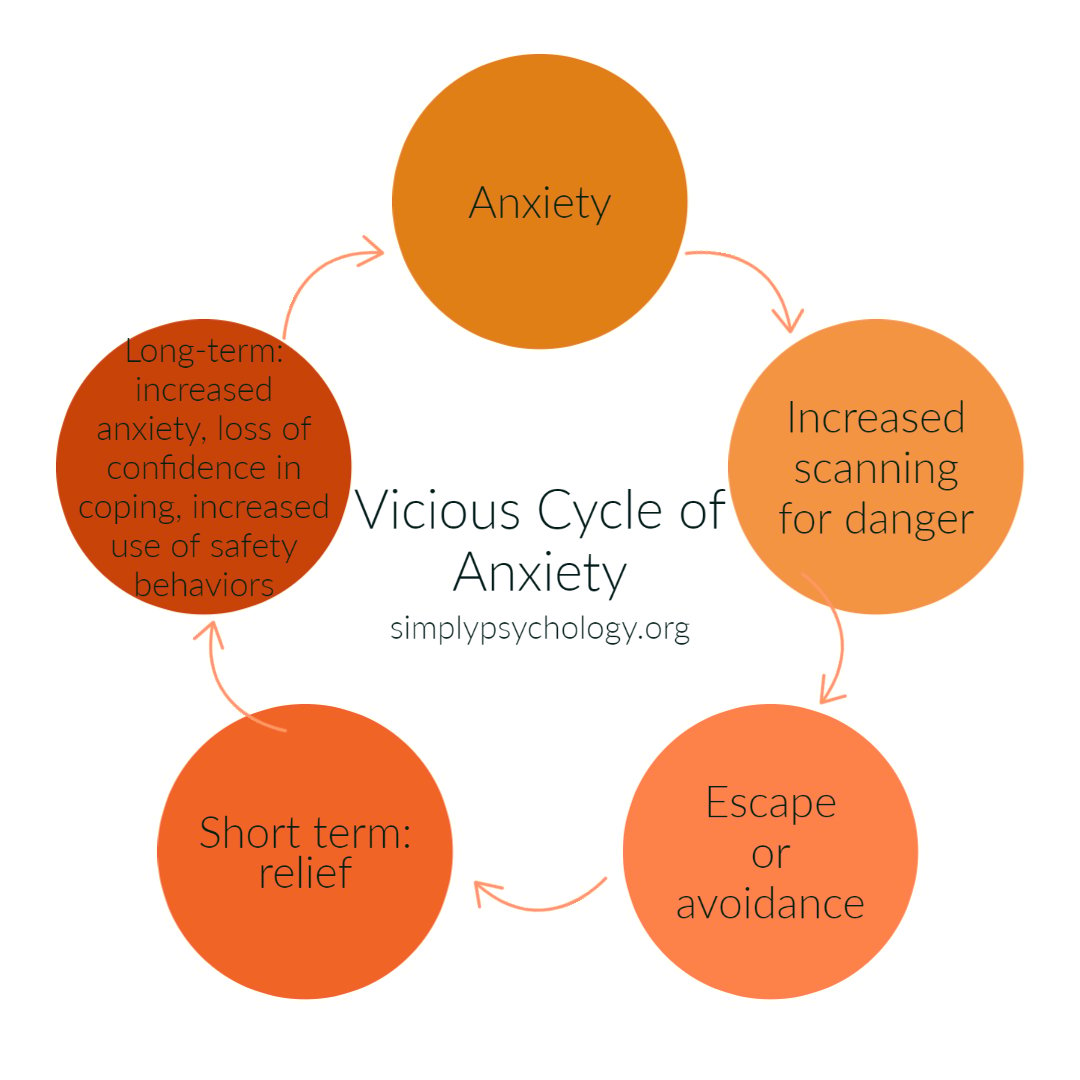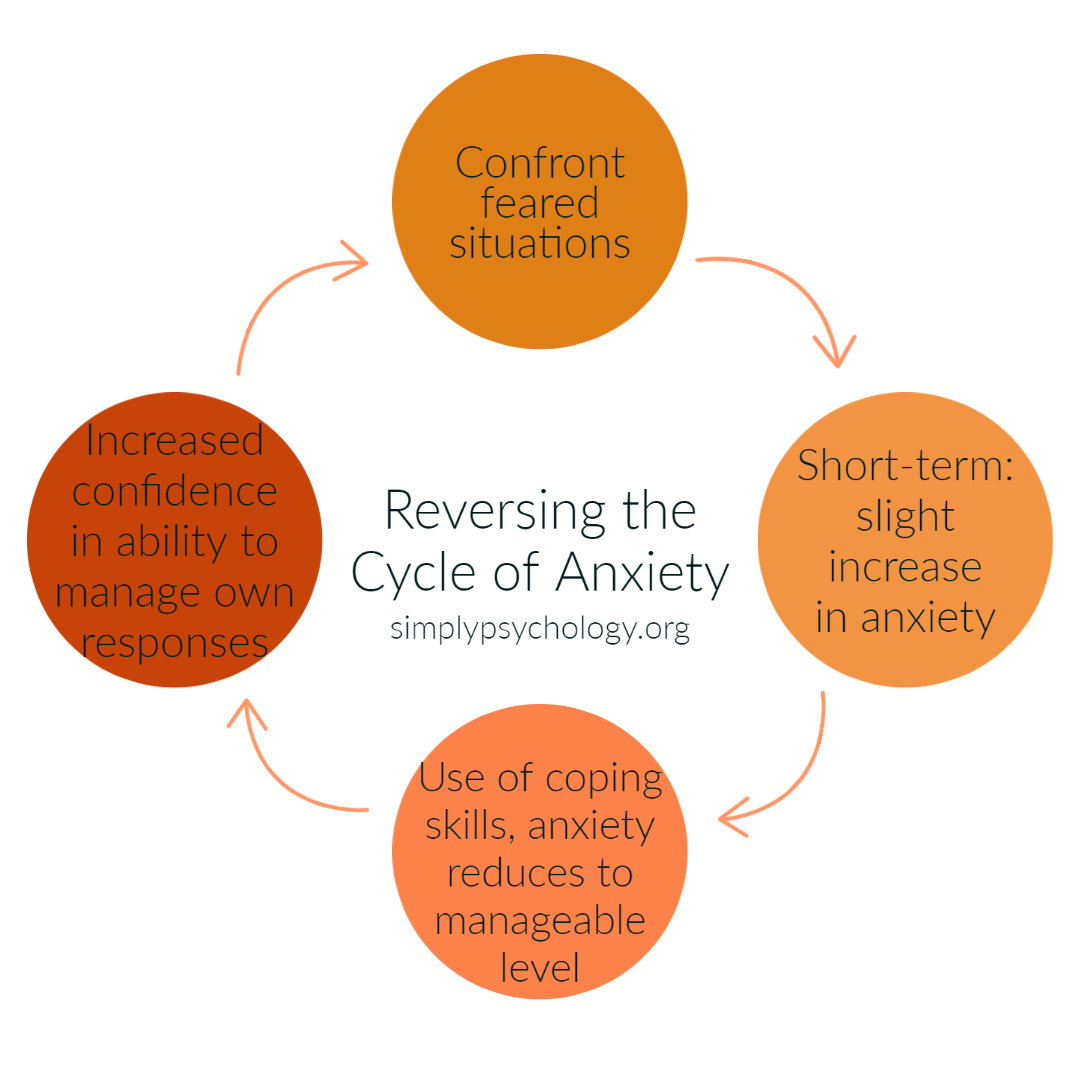On This Page:
Dr. Sanam Hafeez, clinical psychologist, and faculty member at Columbia University, states that:
Anxiety attacks usually occur in reaction to a specific stressor, and are associated with feelings of worry, fear and apprehension. Panic attacks, on the other hand, tend to arise out of the blue and involve feelings of terror, fear and dread.
Sometimes panic attacks and anxiety attacks can be used interchangeably; although they present differently from each other and often feel different, both could involve intense emotions.
Panic Attack vs Anxiety Attack
It may be difficult to know whether you’re experiencing anxiety or a panic attack. Keep in mind the following:
- The symptoms of panic attacks are more severe and intense, while anxiety attacks can range from mild to moderate or severe. Although both share common physical and emotional symptoms, the main difference is that only panic attacks can include a feeling of dread, fear of dying, losing control, and detachment.
- Anxiety attacks persistently occur for prolonged periods, sometimes lasting for days, weeks, or even months. Anxiety attacks usually intensify over time, while panic attacks are typically brief, lasting up to around 30 minutes.
- Panic attacks often seem to come “out of the blue” with no clear warning or triggers. Anxiety is usually related to the anticipation of a stressor, event, or experience, significantly the feeling that something bad is going to happen.
| SYMPTOMS | ANXIETY ATTACK | PANIC ATTACK |
|---|---|---|
| Excessive apprehension and worry | ✓ | |
| Persistent irritability | ✓ | |
| Restlessness and inability to relax, or feeling wound up or on edge | ✓ | |
| Difficulty concentrating or mind going blank | ✓ | |
| Sleep disturbance | ✓ | |
| Easily fatigued | ✓ | |
| Palpitations, pounding heart, or accelerated heart rate | ✓ | ✓ |
| Feeling dizzy, unsteady, light-headed, or faint | ✓ | ✓ |
| Sweating | ✓ | ✓ |
| Nausea or abdominal distress (churning in the stomach) | ✓ | ✓ |
| Fear of losing control or “going crazy” | ✓ | |
| Fear of dying | ✓ | |
| Feel like you are having a heart attack or on the verge of dying | ✓ | |
| Sense of impending doom or danger | ✓ | |
| Derealization (feelings of unreality) or depersonalization (being detached from oneself) | ✓ |
Panic Attacks
What does a panic attack feel like?
Panic attacks come on suddenly and involve significantly intense and often overwhelming fear and discomfort.
Panic attacks can feel severe and have multiple physical symptoms, such as lightheadedness, difficulty breathing, and sometimes chest pain.
However, everyone has a different sensitivity, and the presentation of their physical symptoms will vary.
The main characteristic differentiating panic from anxiety is feeling an impending sense of doom, dread, terror, and worry that something terrible will happen.
The difference between a panic attack and an anxiety attack is that a panic attack is more intense and overwhelming, and it has a more sudden onset. It’s like being hit by a wave, and it can take your breath away. An anxiety attack is more of a slow burn, it builds over time and can last a while.
Andrew Huberman, Neuroscientist at Stanford University School of Medicine

During a panic attack, a person may begin sweating and trembling, their heart starts pounding (and may feel like it will break out of their chest), they may have trouble breathing, and they start to feel extremely dizzy, fearful, and nauseous.
The physical symptom can feel painful or sharp for some people and they may believe they are experiencing a heart attack due to rapid heart rate and chest pain, with some people genuinely believing they are going to die.
It is not uncommon that following a panic attack, people may feel stressed and worried about the occurrence of additional panic attacks or the consequence of losing control.
How long do they last?
A panic attack can start suddenly; symptoms tend to reach their peak after about 10 minutes. After around 30 minutes, the symptoms tend to settle, although the effects may last longer. Usually, panic attacks can last between a few minutes and an hour.
What causes them?
Panic attacks can occur either expectantly or unexpectantly. Expectant panic attacks are usually triggered by an external stressor, such as phobias or excessive self-criticism in certain scenarios.
Unexpected panic attacks could occur without any obvious cause, sometimes happening when previously feeling calm.
Both anxiety and panic attacks can be triggered by identified stressors, but since panic attacks happen more suddenly, they can feel more out of the blue.
However, with more learning and awareness, people can point out the trigger of their panic attacks. For example, they may realize whenever they go to the supermarket, they feel panic.
Whilst the causes of panic attacks are not always known, there are some possible factors, such as brain chemistry, genetics, and hormones, which may play a role in someone being more likely to develop panic attacks.
Similarly, those who have more of an anxious or neurotic type of personality may be more likely to expect a panic attack. Another factor is if a family member, such as a parent or sibling, has an anxiety disorder.
What are some possible triggers for panic attacks?
Although unexpected panic attacks do not seem to be caused by anything in particular, panic attacks can be triggered by similar situations. Below is a list of possible triggers for these types of attacks, although it is worth noting some of the triggers may be specific to a type of anxiety condition:
-
Stressful job
-
Social situations
-
Exposure to a phobia
-
Reminders of traumatic experiences or memories
-
Worries associated with a chronic illness
-
Drug or alcohol withdrawal
-
Overconsumption of caffeine
-
Financial pressure
-
Relationship problems
-
Changing life situations, such as moving house or getting a new job
Can panic attacks occur at any time of day?
Panic attacks can occur very suddenly without any noticeable cause. Because of this, they can occur at any time of the day, including when at work or school, when driving a car, or even in the middle of the night when fast asleep.
Anxiety Attacks
What do they feel like?
Anxiety attacks, unlike panic attacks, are not recognized by the Diagnostic and Statistical Manual of Mental Disorders (DSM-V). However, they are usually experienced as symptoms of other conditions such as generalized anxiety disorder, OCD, health anxiety, social anxiety disorder, or specific phobias.
Anxiety attacks usually present as strong feelings of worry, fear, or distress that may build up gradually. This can also develop into emotional symptoms such as being restless, irritable, and feeling wound up or on edge. A person might experience physical symptoms such as muscle tension and difficulty sleeping.
People’s daily functioning can still be severely impaired by persistent anxiety without having any panic attacks.
How long do they last?
The symptoms of anxiety can often build up and continue for a long period, days or even months at a time.
Anxiety does not tend to peak in the same way that panic does. A person is more likely to stay consistently anxious until the fearful situation is over or until symptoms fade away on their own.
What causes them?
Anxiety is usually related to the anticipation of a stressor, event, or experience, significantly the feeling that something bad will happen.
Triggers for anxiety attacks can depend on the types of anxieties the person has. Someone with a fear of social situations may experience anxiety attacks when having to do a presentation in front of their class or when attending parties with many people.
However, sometimes people may also struggle to identify the stressor of their anxiety. For example, some people can constantly feel anxious without realizing the link to their excessive worries of self-criticism.
People who cannot pinpoint the trigger of their anxiety can experience free-floating anxiety, often experiencing persistent worry when there appears to be no reason for days, weeks, or months on end.
Can anxiety lead to panic?
Some people with anxiety may progress to panic attacks. If a person with panic or anxiety disorder suspects a panic attack may happen, they could experience a rush of anxiety in anticipation of a panic attack.
This can result in all the same symptoms of anxiety attacks which may, in turn, trigger the panic attacks itself.
For example, those who are worried or fearful about enclosed spaces may experience a panic attack when in an elevator.
Certain anxiety conditions can be a cause of anxiety and subsequent panic attacks, and each condition has its own specific causes and associated symptoms:
-
Generalized anxiety disorder – the presence of excessive anxiety and worry about a variety of topics, events, and situations.
-
Obsessive-compulsive disorder – a condition marked by unwanted repeated thoughts (obsessions) and behaviors (compulsions) that interfere with daily life.
-
Social anxiety disorder – a condition associated with the irrational fear and anxiety of being watched, judged, or embarrassing oneself.
-
Specific phobias – this features the irrational fear of an object, place, or situation, e.g., fear of spiders (arachnophobia), or open spaces (agoraphobia).
-
Separation anxiety disorder – the excessive fear of being separated from the primary caregiver.
When Should You Seek Treatment or Support?
It is important to note that anxiety and panic attacks do not largely affect an individual’s daily life for a period of time, as these emotions are normal for a human being to some extent.
It’s worth looking for help if panic attacks or anxiety attacks impact your ability to function normally (e.g., do your job and everyday activities).
Suppose you have started to avoid certain places or situations that cause you distress, such as socializing with certain people or avoiding areas where you have previously experienced anxiety or panic attack. In that case, this is also a sign to seek help.
In the short term, avoiding anxious or fearful situations can make a person feel safe, but this is a problem in the long term as avoidance can keep people anxious.

Diagnosis
To diagnose panic disorder or an anxiety disorder, a discussion with a doctor or mental health professionals, such as psychologists or psychiatrists, is usually the first step to evaluating symptoms.
During this evaluation, the doctor will usually take the individual’s medical history, complete a physical exam, and may undertake other tests to rule out any medical illness that may be contributing to the symptoms.
Questions may be asked about the symptoms being experienced, including their intensity, durations, and the impact they may have on the individual’s normal daily functioning. This will help aid a diagnosis, usually based on the criteria found in the DSM-V.
The DSM-V classifies panic attacks into two clear categories: expected and unexpected. Whilst expected panic attacks are associated with a specific fear, unexpected panic attacks have no apparent trigger.
According to the DSM-V criteria, a panic attack is characterized by four or more of the symptoms that were listed above under ‘Symptoms,’ such as shortness of breath, chest pain, fear of losing control, and fear of dying.
For a diagnosis to be made, the panic attacks must be recurrent, a significant maladaptive change in behavior related to the attacks, and cannot be explained by other means such as through substance misuse or another mental health condition.
For anxiety attacks, it is also recommended to have the same evaluations from a doctor. If the symptoms cannot be explained by a medical condition, a referral to a mental health professional can be made for further evaluation.
Since anxiety attacks are not a formal diagnosis within the DSM-V, instead individuals experiencing these attacks may be diagnosed with a type of anxiety condition such as generalized anxiety or social anxiety disorder, depending on the types of symptoms.
Treatment and Management
People may find that some techniques work better for them than others, whilst some may try a combination of treatments to improve well-being.
Psychotherapy
Psychotherapies are beneficial to better understanding symptoms and developing methods of managing them. Cognitive behavioral therapy (CBT) is a popular psychotherapy recommended for those with panic or other anxiety disorders.
CBT helps individuals identify the thoughts that contribute to fear or anxiety and learn to challenge them, replacing them with realistic and helpful ones.
Exposure therapy is another type of psychotherapy that is mostly recommended for those with specific phobias. This therapy involves gradually exposing the individual to the feared object or situation whilst practicing relaxation techniques.

Over time, the source of the fear should become less frightening for the individual, and there should be fewer anxiety attacks as a result.

Medication
The primary reason for taking medication is to help in reducing symptoms. Medication may only be required for a short period of time to control the symptoms whilst utilizing other strategies.
Antidepressants such as selective serotonin reuptake inhibitors (SSRIs) are commonly prescribed for anxiety disorders as they act on the neurotransmitter serotonin – a chemical associated with mood and feelings of happiness. Examples of SSRIs are Zoloft (Sertraline) and Lexapro (Escitalopram).
Anti-anxiety medications may also be prescribed, including benzodiazepines. Examples of anti-anxiety medications are Xanax (Alprazolam) and Valium (Diazepam). However, benzodiazepines have a high risk of dependence (could be addictive) and should be used with careful monitoring in the short term.
Alternatively, beta blockers can also help with physical symptoms such as heart racing and are not at risk of dependence like benzodiazepines.
Lifestyle
As well as medication and psychotherapy, many lifestyle changes can be made to help manage panic and anxiety attacks. Firstly, it is helpful to understand the signs and triggers of what is causing the panic or anxiety.
Although panic attacks can often seem unexpected, this may be due to a lack of awareness, and “unexpected” could be a subjective term. Thus individuals are encouraged to build awareness in general.
If the source of the triggers is identified, it could be possible to reduce and manage this source. For instance, if overworking at a job is the cause of attacks, adjustments could be made with the employer to ensure the individual is not over-exerting themselves, or the individual can decline to work an extra load if they are significantly affected.
It may also be useful to have a good support network to help the individual talk through their struggles. Confiding in close friends or family members could offload some of the anxiety the person is feeling. Likewise, joining support groups for panic or anxiety can help individuals feel less isolated and learn helpful tips to manage their attacks.
Relaxation exercises have also been found to be beneficial for those with panic and anxiety disorders. This can include trying out yoga, meditating, mindfulness, and deep breathing.
During or immediately after a panic or anxiety attack, it may be useful to complete relaxation exercises to help manage or recover from the intense feelings quicker.
A technique known as progressive muscle relaxation is a method whereby individuals purposely tense a muscle and then release it after a few seconds. A person could start tensing and relaxing their feet, working their way up their body through their legs, arms, and face until their whole body feels more relaxed and focused.
Also, visualization is another technique that can be used during an attack where individuals imagine they are in an environment that is relaxing or safe for them, with the aim of calming their anxious or panicked symptoms.
Finally, other lifestyle techniques such as diet and exercise, have proven to be useful for managing feelings of anxiety and improving mental health in general. Getting adequate sleep and limiting alcohol, drugs and caffeine intake can also be beneficial for those experiencing panic and anxiety attacks.
Do you need mental health support?
USA
Contact the National Suicide Prevention Lifeline for support and assistance from a trained counselor. If you or a loved one are in immediate danger: https://suicidepreventionlifeline.org/
1-800-273-8255
UK
Contact the Samaritans for support and assistance from a trained counselor: https://www.samaritans.org/; email jo@samaritans.org.
Available 24 hours a day, 365 days a year (this number is FREE to call):
116-123
Rethink Mental Illness: rethink.org
0300 5000 927
References
American Psychiatric Association. Diagnostic and Statistical Manual of Mental Disorders. 5th edition. American Psychiatric Association; 2013.
Craske, M.G., Kircanski, K., Zelikowsky, M., Mystkowski, J., Chowdhury, N. & Baker, A. (2008).
Optimizing inhibitory learning during exposure therapy. Behaviour Research and Therapy, 46, 5–27.
Foa, E. B., Kozak, M.J. (1986). Emotional processing of fear: Exposure of corrective information.
Psychological Bulletin, 99, 20–35
Gregory KD, Chelmow D, Nelson HD, et al. Screening for anxiety in adolescent and adult women: A recommendation from the Women’s Preventive Services Initiative. Ann Intern Med. 2020. doi:10.7326/M20-0580
National Institutes of Mental Health. Panic disorder: When fear overwhelms.
National Institute of Mental Health. Anxiety disorders.
Wagner, A. P. (2002). What to do when your child has obsessive-compulsive disorder: Strategies and solutions. Rochester, NY: Lighthouse Press.
Wagner, A. P. (2003). Cognitive-behavioral therapy for children and adolescents with obsessive-compulsive disorder. Brief Treatment and Crisis Intervention, 3 (2), 291-306.


